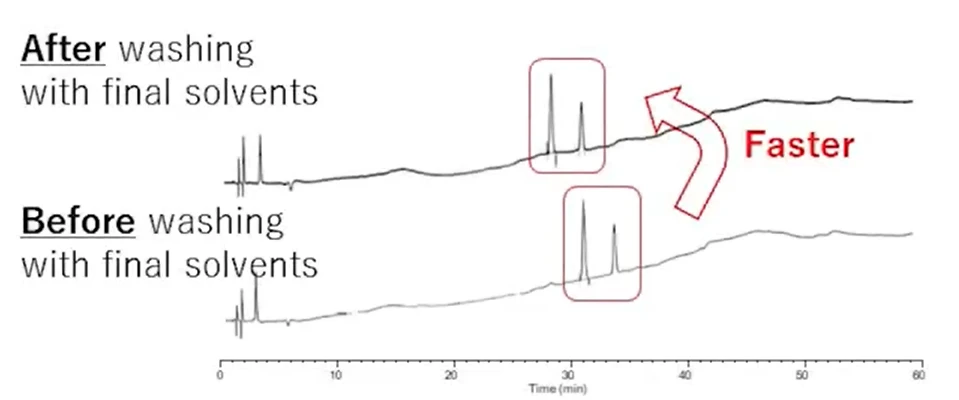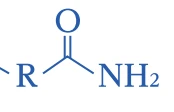HPLC Column Cleaning & Washing Procedure
HPLC Column Cleaning & Washing Procedure
Download PDF Version
This is a guide on the proper procedure for cleaning an HPLC column to remove contaminants that have been retained on the stationary phase of the column. This guide provides step-by-step instructions on how to wash HPLC columns including solvents, wash volumes, and solvent flow rate. After reading, the user should be able to clean their HPLC column and achieve good recovery.
Main principles of HPLC column washing
1. A solvent that is stronger than the mobile phase used in the prior analysis is generally used to wash out any contaminants on the column stationary phase. The choice of solvent is dependent on the chemistry of the stationary phase of your column.
2. A significant excess of solvent is used to flush out contaminants. This normally involves running multiple column volumes' worth of solvent through the column.
3. If initial cleaning with one solvent does not achieve the required recovery, a stronger solvent(s) may be used. Solvent strength is chosen in priority from weakest to strongest, as some stronger solvents have a tendency to permanently affect the retention of the column.
When to clean HPLC columns
Contaminants can cause several issues in your analysis. Consider cleaning your column when experiencing the following:
1. High column pressure - Contaminants retained on the stationary phase can reduce the volume of the flow path for the mobile phase. A column pressure that is 5% higher than a previous run can indicate a column is clogged.
2. Change in selectivity - Adsorbed sample can alter the chemistry of the column, in which case, washing is necessary to restore column selectivity.
3. Deterioration of peak shape - When experiencing deterioration of the peak shape from expectations in your runs such as splitting, tailing, and fronting, a wash may be required to restore column performance.
4. Loss of column efficiency - Contaminants can also lead to noise and loss of theoretical plates.
5. Column storage (more than 10 days) - The last instance is when you have to store your column. Prolonged exposure in adverse acidic, alkaline, or salt conditions can cause deterioration of the column. Make sure to wash your HPLC column before storing it.
HPLC Column Washing Method For Reversed Phase Column (C18, C8, C4, etc.)
Applicable for the following GL Sciences columns in reversed phase mode:
Solvents for washing reversed-phase columns
The following are the most common solvents used for washing reverse-phase columns, arranged in terms of strength:

Water is the weakest solvent and hexane is the strongest solvent. Reverse-phase chromatography usually uses a weak solvent (water) as the mobile phase that it is recommended to try washing first with either methanol or acetonitrile. These solvents can be easily mixed with water. If the results are insufficient, a stronger solvent can be used such as tetrahydrofuran, ethanol, or isopropanol. Isopropanol requires a higher column pressure. If all else fails, use hexane. Hexane does not mix with water, methanol, and acetonitrile and requires application after some of the stronger solvents.
Washing procedure for reversed-phase columns using a weak organic solvent
This is the procedure for washing a reverse-phase column using a weak organic solvent such as methanol or acetonitrile.
1. Create a solvent mixture of 5-20% of either methanol or acetonitrile with water.
2. Wash the column using this solvent mixture to remove precipitated substances such as salts. The volume of solvent mixture to use is 5 times the column volume. For example, a 4.6 mm I.D and 150 mm L column volume has a volume of 2.5 mL; hence, a volume of at least 12.5 mL of the solvent mixture would be used for this column. A flow rate of 1.0 mL/min is generally advised for all flushing in this procedure.
Note: When observing excessive back pressure, reduce and adjust the flow rate.
How to calculate column volume
Here are the column volumes of some columns with the following dimensions:

| Column Dimension |
Column Volume |
| 4.6 mm I.D. x 250 mm L |
4.2 mL |
| 4.6 mm I.D. x 150 mm L |
2.5 mL |
| 4.6 mm I.D. x 50 mm L |
0.8 mL |
| 3.0 mm I.D. x 250 mm L |
1.8 mL |
| 3.0 mm I.D. x 150 mm L |
1.1 mL |
| 3.0 mm I.D. x 50 mm L |
0.4 mL |
| 2.1 mm I.D. x 150 mm L |
0.5 mL |
| 2.1 mm I.D. x 100 mm L |
0.3 mL |
| 2.1 mm I.D. x 50 mm L |
0.2 mL |
4. Wash the column with 100% weak organic solvent (methanol or acetonitrile, whichever was chosen in step 1) using a volume that is 10 times the column volume.
5. Once again wash the column using the prepared (in step 1) 5-20% mixed solution of water and organic solvent with a volume that is 5 times the column volume.
6. Check column recovery by running under normal analysis conditions or prepare the column for storage by running with storage solvent.
Washing procedure for reversed-phase columns using a strong organic solvent
This is the procedure for solvents including tetrahydrofuran, ethanol and 2-propanol but not including hexane.
1. Wash the column with 5-20% solvent mixture of weak organic solvent (either methanol or acetonitrile; see Washing procedure for reversed-phase columns using a weak organic solvent). The volume of solvent mixture to use is 5 times the column volume. A flow rate of 1.0 mL/min is generally advised for all flushing in this procedure.
2. Flow the column with 100% weak organic solvent using a volume that is 5 times the column volume.
3. Flow the column with 100% strong organic solvent - either tetrahydrofuran, ethanol or 2-propanol - using a volume that is 10 times the column volume.
4. Wash the column again (repeat step 2) with 100% weak organic solvent using a volume that is 5 times the column volume.
5. Wash the column again (repeat step 1) with 5-20% solvent mixture of weak organic solvent using a volume that is 5 times the column volume.
6. Check column recovery by running under normal analysis conditions or prepare the column for storage by running with storage solvent.
Washing procedure for reversed-phase columns using hexane
Note that hexane only mixes with strong organic solvents and is not miscible with weak organic solvents and water.
1. Wash the column with 5-20% solvent mixture of weak organic solvent (either methanol or acetonitrile; see Washing procedure for reversed-phase columns using a weak organic solvent) using a volume of solvent mixture that is 5 times the column volume. A flow rate of 1.0 mL/min is generally advised for all flushing in this procedure.
2. Wash the column with 100% weak organic solvent using a volume that is 5 times the column volume.
3. Wash the column with 100% strong organic solvent - either tetrahydrofuran, ethanol or 2-propanol using a volume that is 10 times the column volume.
4. Wash the column with 100% hexane using a volume that is 10 times the column volume.
5. Wash the column again (repeat step 3) with 100% strong organic solvent using a volume that is 10 times the column volume.
6. Wash the column again (repeat step 2) with 100% weak organic solvent using a volume that is 5 times the column volume.
7. Wash the column again (repeat step 1) with 5-20% solvent mixture of weak organic solvent using a volume.
8. Check column recovery by running under normal analysis conditions or prepare the column for storage by running with storage solvent.
HPLC Column Washing Method For Normal Phase Column
Applicable for the following GL Sciences columns in normal phase mode:
Solvents for washing normal phase columns
The following are the most common solvents used for washing normal phase columns, arranged in terms of strength:

A weak solvent is usually used as the mobile phase for a normal phase column but washing may require a strong solvent. It is rare to flow water through a column used in normal phase mode. Isopropanol or ethanol are recommended solvents as these are easily mixed with most solvents such as hexane used in normal phase mode. If the column recovery is insufficient, methanol or water can be used. However, normal phase columns flushed with water or methanol may change retention properties.
Wash the column with 5-20% solvent mixture of weak organic solvent (either methanol or acetonitrile; see Washing procedure for reversed-phase columns using a weak organic solvent) using a volume of solvent mixture that is 5 times the column volume. A flow rate of 1.0 mL/min is generally advised for all flushing in this procedure.
Washing procedure for normal phase columns using isopropanol or ethanol
1. Flow 5 times the column volume of 100% isopropanol or ethanol through the column. A flow rate of 0.2 mL/min is generally advised for all flushing in this procedure. Note: Take care about high pressure when using isopropanol. These solvents tend to increase the column pressures so it is recommended to use a lower rate than usual.
2. Wash the column with 100% hexane using a volume that is 5 times the column volume.
3. Check column recovery by running under normal analysis conditions or prepare the column for storage by running with storage solvent.
Washing procedure for normal phase columns using water or methanol
Note that using water or methanol can permanently change the retention of the column. Columns can become irreversibly faster or stabilize with a faster retention time. It is only recommended to use water or methanol when you are able to accept this situation.

1. Wash the column with 100% isopropanol or ethanol using a volume that is 5 times the column volume. Take care about high pressure when using isopropanol.
2. Wash the column with 100% water or methanol using a volume that is 10 times the column volume.
3. Wash the column again with 100% isopropanol or ethanol using a volume that is 5 times the column volume.
4. Wash the column with 100% hexane using a volume that is 5 times the column volume.
5. Check column recovery by running under normal analysis conditions or prepare the column for storage by running with storage solvent.
HPLC Column Washing Method For HILIC Column
HILIC stands for Hydrophilic Interaction Liquid Chromatography. HILIC is a variation of normal phase mode that also partially overlaps with ion chromatography and reversed phase mode. The chemical bonding material is one containing a polar functional group, similar to normal phase mode, while an organic solvent is used as mobile phase such as acetonitrile.
Solvents for washing HILIC columns
The following are the most common solvents used for washing HILIC columns, arranged in terms of strength:

In HILIC mode, it is common to use acetonitrile and water as mobile phase so that, for the first wash, it is recommended to use a mixed solution of acetonitrile and water. The mixing ratio depends on the chemical bonding group of the column.
HILIC columns are divided into two groups for washing: a high water solvent group which can be washed with a solvent with 50% to 100% water content and a low water solvent group which can only be washed using a solvent with 50% or less water content.
GL Sciences HILIC phases grouped by solvent water content with corresponding functional groups
If the washing is insufficient using acetonitrile and water, add salt or acid to the acetonitrile and water solvent mixture.
Washing procedure for high water solvent HILIC columns
This procedure applies for the following GL Sciences columns in HILIC mode: InertSustain Amide (carbamoyl) and Inertsil HILIC (dihydroxypropyl)
Basic method
1. Flow a mixture of 90% acetonitrile and 10% water through the column. The volume to use is more than 10 times the column volume.
2. Wash with a solvent with an increased water ratio: 50-100% water to acetonitrile. The volume to use is more than 10 times the column volume.
3. Wash with 100% of acetonitrile and run 5 times the column volume.
4. Check column recovery by running under normal analysis conditions or prepare the column for storage by running with storage solvent.
Advanced method
If the previous washing methods introduced so far do not improve, try an advanced washing method using an acetonitrile-water solvent with salts such as ammonium formate.
1. Flow a mixture of 90% acetonitrile and 10% water through the column more than five times the column volume.
2. Flow 100% water more than 5 times the column volume.
3. Flow 50 millimole (mM) of ammonium formate or ammonium acetate aqueous solution more than 20 times the column volume. Note: It is not recommended to use phosphate buffer due to possible salt precipitation
4. Flow 100% water more than 5 times the column volume.
5. Wash with 100% acetonitrile and run 5 times the column volume.
6. Check column recovery by running under normal analysis conditions or prepare the column for storage by running with storage solvent.
Washing procedure for low water solvent HILIC columns
This procedure applies for the following GL Sciences columns in HILIC mode: InertSustain NH2 (aminopropyl), Inertsil NH2 (aminopropyl), and Inertsil Amide (carbamoyl)
Basic method
1. Flow a mixture of 90% acetonitrile and 10% water through the column. The volume to use is more than 10 times the column volume.
2. Wash with a solvent with a 50/50 water to acetonitrile solution. The volume to use is more than 10 times the column volume.
3. Wash with 100% of acetonitrile and run 5 times the column volume.
4. Check column recovery by running under normal analysis conditions or prepare the column for storage by running with storage solvent.
Advanced method
If the previous washing methods introduced so far do not improve, try an advanced washing method using an acetonitrile-water solvent with salts such as ammonium formate.
1. Flow a mixture of 90% acetonitrile and 10% water through the column more than five times the column volume.
2. Flow with 50/50 water to acetonitrile solution more than 5 times the column volume.
3. Flow 50 millimole (mM) of ammonium formate or ammonium acetate aqueous solution more than 20 times the column volume. Note: It is not recommended to use phosphate buffer due to possible salt precipitation
4. Flow with 50/50 water to acetonitrile solution more than 5 times the column volume.
5. Wash with 100% acetonitrile and run 5 times the column volume.
6. Check column recovery by running under normal analysis conditions or prepare the column for storage by running with storage solvent.
Leave a comment


 Español (Taducido por Google)
Español (Taducido por Google)









